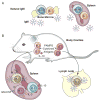A Hard(y) Look at B-1 Cell Development and Function
- PMID: 29109178
- PMCID: PMC5726597
- DOI: 10.4049/jimmunol.1700943
A Hard(y) Look at B-1 Cell Development and Function
Abstract
A small population of B cells exists in lymphoid tissues and body cavities of mice that is distinct in development, phenotype, and function from the majority (B-2) B cell population. This population, originally termed "Ly-1" and now "B-1," has received renewed interest as an innate-like B cell population of fetal-derived hematopoiesis, responsible for natural Ab production and rapid immune responses. Molecular analyses have begun to define fetal and adult hematopoiesis, while cell-fate mapping studies have revealed complex developmental origins of B-1 cells. Together the studies provide a more detailed understanding of B-1 cell regulation and function. This review outlines studies that defined B-1 cells as natural Ab- and cytokine-producing B cells of fetal origin, with a focus on work conducted by R.R. Hardy, an early pioneer and codiscoverer of B-1 cells, whose seminal contributions enhanced our understanding of this enigmatic B cell population.
Copyright © 2017 by The American Association of Immunologists, Inc.
Figures


Similar articles
-
Role of B-1a cells in autoimmunity.Autoimmun Rev. 2006 Jul;5(6):403-8. doi: 10.1016/j.autrev.2005.10.007. Epub 2005 Dec 9. Autoimmun Rev. 2006. PMID: 16890894 Review.
-
Development, phenotype, and function of non-conventional B cells.Comp Immunol Microbiol Infect Dis. 2017 Oct;54:38-44. doi: 10.1016/j.cimid.2017.08.002. Epub 2017 Aug 26. Comp Immunol Microbiol Infect Dis. 2017. PMID: 28916000 Review.
-
Distinctive developmental origins and specificities of the CD5+ B-cell subset.Semin Immunol. 1996 Feb;8(1):37-44. doi: 10.1006/smim.1996.0006. Semin Immunol. 1996. PMID: 8850297 Review.
-
Innate-like B cells and their rules of engagement.Adv Exp Med Biol. 2013;785:57-66. doi: 10.1007/978-1-4614-6217-0_7. Adv Exp Med Biol. 2013. PMID: 23456838 Review.
-
Protective Humoral Immunity in the Central Nervous System Requires Peripheral CD19-Dependent Germinal Center Formation following Coronavirus Encephalomyelitis.J Virol. 2017 Nov 14;91(23):e01352-17. doi: 10.1128/JVI.01352-17. Print 2017 Dec 1. J Virol. 2017. PMID: 28931676 Free PMC article.
Cited by
-
The dualistic role of Lyn tyrosine kinase in immune cell signaling: implications for systemic lupus erythematosus.Front Immunol. 2024 Jun 28;15:1395427. doi: 10.3389/fimmu.2024.1395427. eCollection 2024. Front Immunol. 2024. PMID: 39007135 Free PMC article. Review.
-
Identification of a Sensitive Human Immunological Target of Aryl Hydrocarbon Receptor Activation: CD5+ Innate-Like B Cells.Front Immunol. 2021 Apr 15;12:635748. doi: 10.3389/fimmu.2021.635748. eCollection 2021. Front Immunol. 2021. PMID: 33936048 Free PMC article.
-
Optimized Detection of Acute MHV68 Infection With a Reporter System Identifies Large Peritoneal Macrophages as a Dominant Target of Primary Infection.Front Microbiol. 2021 Mar 9;12:656979. doi: 10.3389/fmicb.2021.656979. eCollection 2021. Front Microbiol. 2021. PMID: 33767688 Free PMC article.
-
Antidepressants cheer up hepatic B1 B cells: Hope for the treatment of autoimmune liver diseases?Front Immunol. 2023 Jan 17;13:1083173. doi: 10.3389/fimmu.2022.1083173. eCollection 2022. Front Immunol. 2023. PMID: 36733387 Free PMC article. No abstract available.
-
Immunization of preterm infants: current evidence and future strategies to individualized approaches.Semin Immunopathol. 2022 Nov;44(6):767-784. doi: 10.1007/s00281-022-00957-1. Epub 2022 Aug 3. Semin Immunopathol. 2022. PMID: 35922638 Free PMC article. Review.
References
-
- Royston I, Majda JA, Baird SM, Meserve BL, Griffiths JC. Human T cell antigens defined by monoclonal antibodies: the 65,000-dalton antigen of T cells (T65) is also found on chronic lymphocytic leukemia cells bearing surface immunoglobulin. J Immunol. 1980;125:725–731. - PubMed
-
- Bondada S, Bikah G, Robertson DA, Sen G. Role of CD5 in growth regulation of B-1 cells. Curr Top Microbiol Immunol. 2000;252:141–149. - PubMed
Publication types
MeSH terms
Substances
Grants and funding
LinkOut - more resources
Full Text Sources
Other Literature Sources

